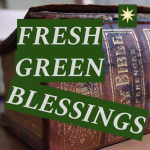
Jeremiah 10:12-13,16b: It is he who made the earth by his power, who established the world by his wisdom, and by his understanding stretched out the heavens. When he utters his voice, there is a tumult of waters in the heavens, and he makes the mist rise from the ends of the earth. He makes lightnings for the rain, and he brings out the wind from his storehouses…for he is the one who formed all things.
∞∞∞∞∞∞∞∞
Jeremiah 10:1-16 is a polemic against the worship of carved wooden images painted with silver and gold by artisans. Jeremiah says that they are “like scarecrows in a cucumber field, and they cannot speak; they have to be carried, for they cannot walk” (v. 5).
For Jeremiah, the Great Sacredness is a living, breathing G-d who is deeply immersed in Earthly life, “He makes the mist rise from the ends of the earth. He makes lightnings for the rain, and he brings out the wind from his storehouses.”
One with even a rudimentary knowledge of Earth sciences or meteorology and weather patterns might smile condescendingly at Jeremiah’s primitive understanding, but please do not allow a rational, empirical mindset to negate your access to the poetry and epistemology behind Jeremiah’s words. To view the “quaking Earth” (v. 10) or the “rising mist” (v. 12) as G-d-powered (v. 12) may appear quaint and archaic, but to embrace Jeremiah’s way-of-knowing is to experience each flash of lightning and gust of wind (v. 12) as sacred; it is to embrace every element of the natural world as G-d-inspired; it is to celebrate every act of nature as imbued with the Sacred – and, dear Lord, what positive environmental change could be wrought if we would even begin to look at our Earth through such eyes?
This is not an other-worldly theology focused on individual eternal prizes given to the selves with the greatest self-focus on their individual salvation. No, this is a theology of wholeness – a theological embrace of the entire Earth. This is a theology wherein G-d is alive in this present moment, voiced in “a tumult of water” (v. 13), wrathful in an earthquake (v. 10), breathing and being with us here on this planet, in this present, “the one who formed all things.”
∞∞∞∞∞∞∞∞
We tend to think of scientific or empirical thinking and spiritual or religious thinking like a single light switch: To turn on one is to turn off the other; to turn on religious thinking is to turn off empirical thinking OR to turn on scientific reasoning is to douse the light of a spiritual worldview. Need we be so naively dualistic? A room can be lit by an overhead light that allows us to delineate lines and contours and examine details with meticulousness. Alternatively, a candle or small lamp can be used for lighting, allowing for shadows and darkness, giving us a diffused melding of lines and contours while creating a “warm feel” in the room. Is one truth and the other a lie? Might a candle-lit room create an experience that is palpably different than that created by good, strong fluorescent lighting, but no less true? Can we access “various lighting” at different times? Can we even simultaneously combine different types of lighting – creating new experiences – giving us fresh insights, new perspectives, greater understanding, and fueling further curiosity about all that exists in the room?
(Music: Courtesy of Adrian Von Ziegler, “Circle of Life.” )